
A Survivor from H.M.S Hermes
A War Biography of Percy Bell, Royal Marine and Hermes Survivor 1916-1975
By Maureen Bell
Note from the editor :
On 24th of September 2010 Maureen Bell, the daughter of late Percy Bell, wrote to us with photos and an account of her late fathers experience of survival during and after the attack on H.M.S Hermes by Japanese on the 9th of April 1942. This is the story of how Percy Bell lived onboard the Hermes & survived an experience which Prime Minister Winston Churchill later called the "most dangerous moment" in the World War II. This is her letter unaltered.
Percy Bell
Hermes aircraft carrier Photo from the book Hermes Adventure
My dad was born in London, England on November 11, 1916. He lived there with his parents until he was 6 years old when they immigrated to Canada and settled in Winnipeg , Manitoba . As a boy his interests were Boy Scouts and sports, mainly hockey and baseball. He became a very good hockey goalie and when he was 18, he had the opportunity to return to England to play on one of their semi-professional hockey teams. He settled in Harringey and lived there until he joined the British Navy in 1938 at the age of 22.
Having a love of travel, the sea and adventure, my dad settled into this new role as a British Marine with enthusiasm and enjoyment. He loved the opportunity to visit new places and often talked about his travels and his desire to return to Cape Town , South Africa .
Growing up, there was one story in particular that intrigued my sisters and I the most. It was the story of the day the Hermes went down and we loved to hear it told by our Dad. This is his story.
Val bomber photo from www.airspacemag.com
Sinking of the Hermes in the Indian Ocean off the coast of Ceylon
April 9, 1942
It all started on April 9, 1942 at 0600, when 91 Aichi D3A1 Val dive-bombers and 41 Mitsubishi A6M2 Zeke fighters were ordered to attack the British naval base at Trincomalee, Ceylon. They found the harbor empty but wrecked the base's facilities and shot down nine planes.
At 0900, a reconnaissance aircraft spots the ships 65 miles south of the base. The HMS Hermes, the first purpose built aircraft carrier to be ordered by any navy, under the command of Capt. R. Onslow, left the naval base of Trincomalee, Ceylon, escorted by the Australian destroyer Vampire .
Vice Admiral Nagumo ordered the force of Val single engine dive bombers to fly off his carriers Akagai (flagship), Hiryu, and Soryu and attack. He ordered 45 planes to attack the Hermes and the remainder to attack the Vampire, Hollyhock, British Sergeant, Athelstane, Pearleaf, and Teviotbank. Hermes had no aircraft on board and was defenseless against the forthcoming attack. The attack against the Hermes commenced at 10:35 am and was completed at 10:50 am. She sank almost immediately, taking about 20 minutes to go down, sinking at 10:55 am. Vampire, Hollyhock, British Sergeant and Athelstane were all sunk along with the Hermes. By extraordinary good fortune, Pearleaf and Teviotbank either were overlooked or were not spotted and both returned safely to Trinco.
The Hermes received 37 direct hits from the 550 lb. bombs that were dropped on it; another 8 were near misses from which the ship received heavy damage. There were
780 on board: 307 lost, 456 picked up, 16 swam to shore.
My dad (aka Darkie Bell to his shipmates) was one of those who swam to the shores of Ceylon (now Sri Lanka), a distance of about 5 miles. The survivors in the water were strafed by the Japanese and dad received a severe injury, blast lung, from the several bombs which exploded near him. Disoriented from his injury, sometimes floating, sometimes swimming, it took him 2 days to make it to shore. My dad often said the dolphins saved his life. They kept him alive by staving off the sharks and poking him in the belly to keep him awake. He landed onshore and was helped by the local villagers. During this period of time, from April until December 1942 he was declared missing.
The wreck of the Hermes was found approximately 25 years later, about five nautical miles from shore and fifty-seven meters down. It is now a wreck diver's paradise.
The wreck of the Vampire has never been found. It is believed to be in a deep trench too far down for exploration equipment.
After Dad returned to England in 1942, a period of convalescence followed in Paignton, England. He was then discharged in April 1944 and joined the Royal Canadian Naval Volunteer Reserve as an Able Seaman serving on the ship Loch Morlich. After being discharged from the Reserve in 1945 he returned to Winnipeg . He was awarded the following medals:
• 1939 45 Star for 6 months service in areas of active operations between Sept. 1939 & 1945
• Atlantic Star for 6 months service in the Atlantic or Home waters between Sept. 1939 & 1945
• Africa Star for service at sea in the Mediterranean between June 1940 and May 1943
• Burma Star for service in the Bay of Bengal and areas of the Indian Ocean between 1941 & 1945
• Defence Medal for serving 6 months in areas subjected to enemy air attack
• War Medal for full time service between Sept. 1939 and Sept. 1945
Bob Diemert, 1968,Carman, Manitoba, Photo courtesy of Blake W. Smith
My Dad's love of the water never waned after his Hermes adventure. Together with my mother, they built our family cottage at Moose Lake and his passion was still boating, fishing and swimming. My sisters and I often marveled at our dad's swimming skills and never questioned why he didn't wear a life jacket!
Written by Maureen Bell, daughter
email:
maureenbell@shaw.ca
September 2010
The following pages of pictures are all from Dad's photo album
with captions that he wrote:
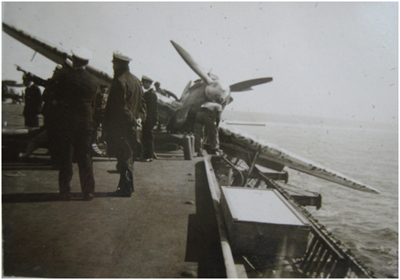 Crash!
Crash!
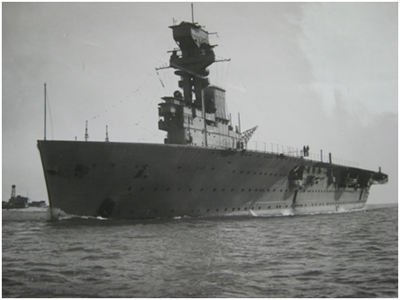

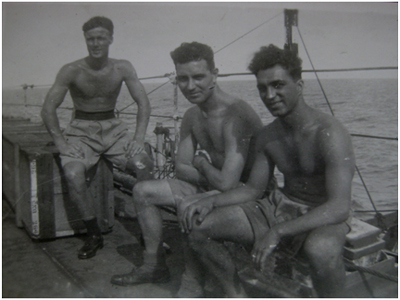
Left: Taken with two of my mess mates. The towel is to wipe off the sweat. 1941
Above: Spike, Mic and myself
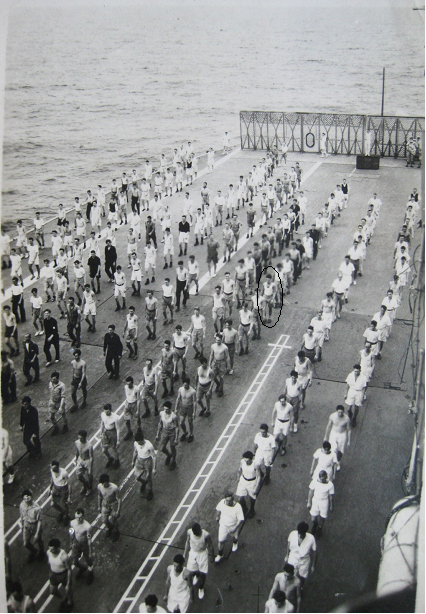
PT on the flight deck (There's my dad! - circled in red)
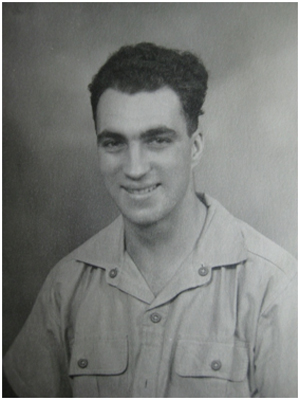
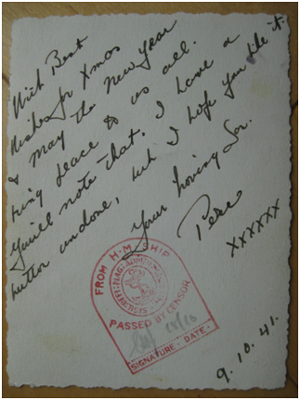
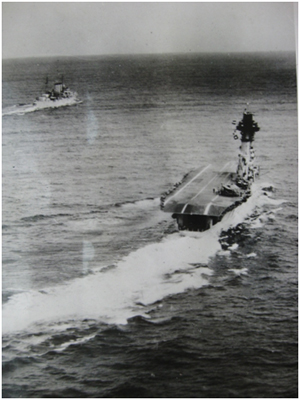
H.M.S Cornwall and the H.M.S Hermes
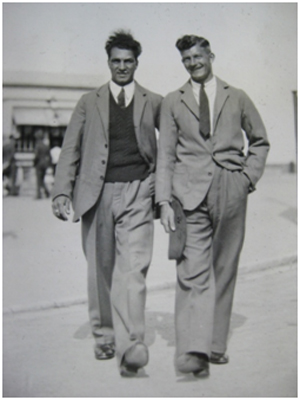
Myself and friend while convalescent
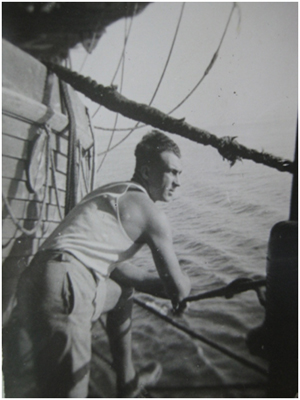
It's a long way off!

Declared missing

In dry dock at Capetown
From the naval historical branch:
During the night of the 10 th of July, 1940 in a sudden dense tropical storm the HERMES collided with the armed merchant cruiser CORFU. She suffered severe damage to her bows and the fore end of her flight deck but reached Freetown that evening under her own steam. She arrived at Simonstown next month for refit which lasted until November.